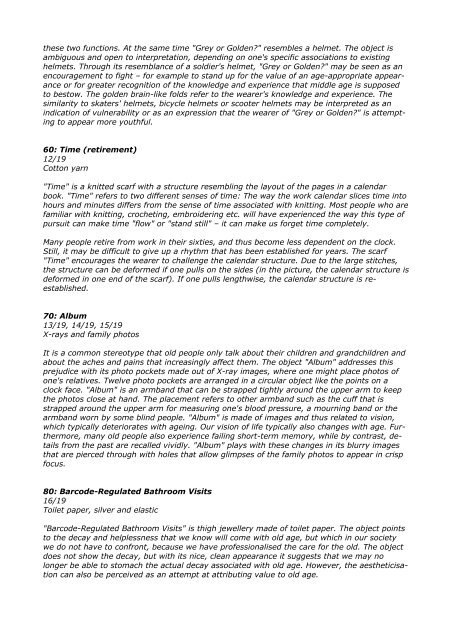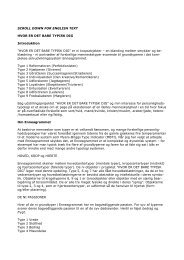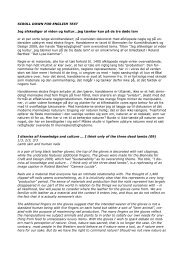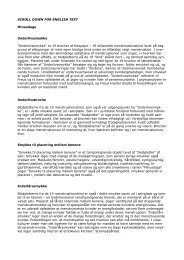SCROLL DOWN FOR ENGLISH TEXT Livsaldre ... - katrine borup
SCROLL DOWN FOR ENGLISH TEXT Livsaldre ... - katrine borup
SCROLL DOWN FOR ENGLISH TEXT Livsaldre ... - katrine borup
Create successful ePaper yourself
Turn your PDF publications into a flip-book with our unique Google optimized e-Paper software.
these two functions. At the same time "Grey or Golden?" resembles a helmet. The object is<br />
ambiguous and open to interpretation, depending on one's specific associations to existing<br />
helmets. Through its resemblance of a soldier's helmet, "Grey or Golden?" may be seen as an<br />
encouragement to fight – for example to stand up for the value of an age-appropriate appearance<br />
or for greater recognition of the knowledge and experience that middle age is supposed<br />
to bestow. The golden brain-like folds refer to the wearer's knowledge and experience. The<br />
similarity to skaters' helmets, bicycle helmets or scooter helmets may be interpreted as an<br />
indication of vulnerability or as an expression that the wearer of "Grey or Golden?" is attempting<br />
to appear more youthful.<br />
60: Time (retirement)<br />
12/19<br />
Cotton yarn<br />
"Time" is a knitted scarf with a structure resembling the layout of the pages in a calendar<br />
book. "Time" refers to two different senses of time: The way the work calendar slices time into<br />
hours and minutes differs from the sense of time associated with knitting. Most people who are<br />
familiar with knitting, crocheting, embroidering etc. will have experienced the way this type of<br />
pursuit can make time "flow" or "stand still" – it can make us forget time completely.<br />
Many people retire from work in their sixties, and thus become less dependent on the clock.<br />
Still, it may be difficult to give up a rhythm that has been established for years. The scarf<br />
"Time" encourages the wearer to challenge the calendar structure. Due to the large stitches,<br />
the structure can be deformed if one pulls on the sides (in the picture, the calendar structure is<br />
deformed in one end of the scarf). If one pulls lengthwise, the calendar structure is reestablished.<br />
70: Album<br />
13/19, 14/19, 15/19<br />
X-rays and family photos<br />
It is a common stereotype that old people only talk about their children and grandchildren and<br />
about the aches and pains that increasingly affect them. The object "Album" addresses this<br />
prejudice with its photo pockets made out of X-ray images, where one might place photos of<br />
one's relatives. Twelve photo pockets are arranged in a circular object like the points on a<br />
clock face. "Album" is an armband that can be strapped tightly around the upper arm to keep<br />
the photos close at hand. The placement refers to other armband such as the cuff that is<br />
strapped around the upper arm for measuring one's blood pressure, a mourning band or the<br />
armband worn by some blind people. "Album" is made of images and thus related to vision,<br />
which typically deteriorates with ageing. Our vision of life typically also changes with age. Furthermore,<br />
many old people also experience failing short-term memory, while by contrast, details<br />
from the past are recalled vividly. "Album" plays with these changes in its blurry images<br />
that are pierced through with holes that allow glimpses of the family photos to appear in crisp<br />
focus.<br />
80: Barcode-Regulated Bathroom Visits<br />
16/19<br />
Toilet paper, silver and elastic<br />
"Barcode-Regulated Bathroom Visits" is thigh jewellery made of toilet paper. The object points<br />
to the decay and helplessness that we know will come with old age, but which in our society<br />
we do not have to confront, because we have professionalised the care for the old. The object<br />
does not show the decay, but with its nice, clean appearance it suggests that we may no<br />
longer be able to stomach the actual decay associated with old age. However, the aestheticisation<br />
can also be perceived as an attempt at attributing value to old age.





